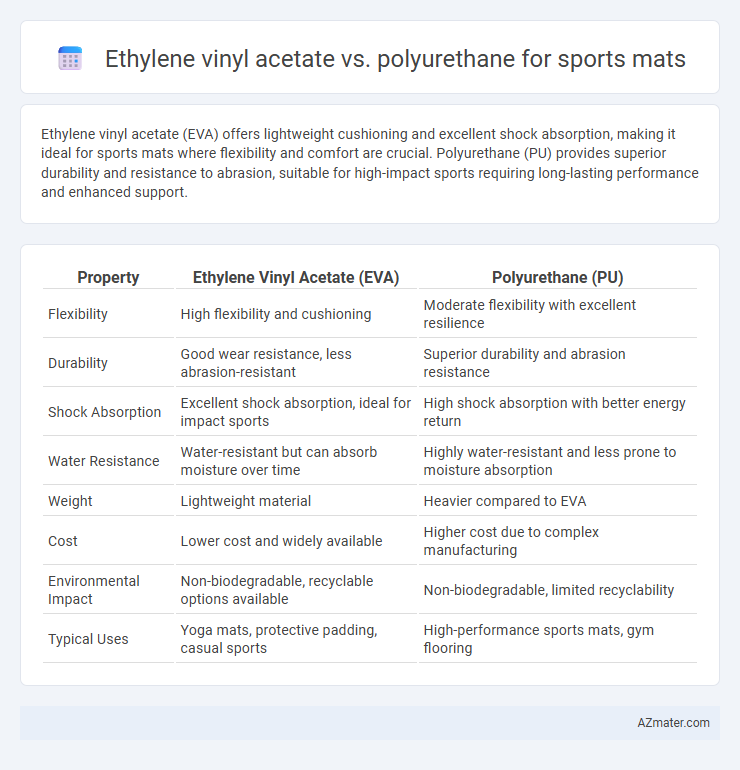Ethylene vinyl acetate (EVA) offers lightweight cushioning and excellent shock absorption, making it ideal for sports mats where flexibility and comfort are crucial. Polyurethane (PU) provides superior durability and resistance to abrasion, suitable for high-impact sports requiring long-lasting performance and enhanced support.
Table of Comparison
| Property | Ethylene Vinyl Acetate (EVA) | Polyurethane (PU) |
|---|---|---|
| Flexibility | High flexibility and cushioning | Moderate flexibility with excellent resilience |
| Durability | Good wear resistance, less abrasion-resistant | Superior durability and abrasion resistance |
| Shock Absorption | Excellent shock absorption, ideal for impact sports | High shock absorption with better energy return |
| Water Resistance | Water-resistant but can absorb moisture over time | Highly water-resistant and less prone to moisture absorption |
| Weight | Lightweight material | Heavier compared to EVA |
| Cost | Lower cost and widely available | Higher cost due to complex manufacturing |
| Environmental Impact | Non-biodegradable, recyclable options available | Non-biodegradable, limited recyclability |
| Typical Uses | Yoga mats, protective padding, casual sports | High-performance sports mats, gym flooring |
Introduction to Sports Mat Materials
Ethylene vinyl acetate (EVA) and polyurethane (PU) are two of the most common materials used for sports mats, offering distinct properties suited to athletic environments. EVA provides excellent shock absorption, lightweight flexibility, and resistance to moisture, making it ideal for activities requiring cushioning and comfort. Polyurethane stands out for its superior durability, high resilience, and resistance to abrasion, supporting heavy-impact sports and long-term use.
Overview of Ethylene Vinyl Acetate (EVA)
Ethylene Vinyl Acetate (EVA) is a lightweight, flexible polymer commonly used in sports mats for its excellent shock absorption and cushioning properties. EVA offers high durability, resistance to stress cracking, and EVA foam mats provide enhanced comfort and reduced impact on joints during athletic activities. Its closed-cell structure ensures water resistance and easy maintenance, making it a preferred choice for indoor and outdoor sports environments.
Overview of Polyurethane (PU)
Polyurethane (PU) sports mats offer superior durability, elasticity, and shock absorption compared to Ethylene Vinyl Acetate (EVA), making them ideal for high-impact athletic activities. PU mats exhibit excellent resistance to abrasion, chemicals, and UV radiation, ensuring long-lasting performance in both indoor and outdoor environments. Their dense, resilient structure provides enhanced comfort and injury prevention for athletes through efficient energy return and consistent surface stability.
Cushioning and Shock Absorption Comparison
Ethylene vinyl acetate (EVA) offers excellent cushioning due to its closed-cell foam structure, providing superior shock absorption ideal for sports mats where impact reduction is critical. Polyurethane (PU) excels in durability and resilience, maintaining consistent cushioning over prolonged use but may absorb less shock compared to EVA's softer composition. For sports mats prioritizing maximum impact attenuation and comfort, EVA's lightweight, flexible material often outperforms polyurethane in cushioning and shock absorption efficiency.
Durability and Lifespan Analysis
Ethylene vinyl acetate (EVA) sports mats offer excellent shock absorption and are lightweight, but they are prone to surface wear and compression over time, typically lasting 3 to 5 years under heavy use. Polyurethane (PU) mats boast superior durability with greater resistance to abrasion, tearing, and chemical damage, extending their lifespan to 7 to 10 years in intense athletic environments. The higher density and elasticity of polyurethane result in prolonged structural integrity, making PU mats a more cost-effective solution for long-term sports facility investments.
Comfort and User Experience
Ethylene vinyl acetate (EVA) sports mats offer superior cushioning and shock absorption, enhancing comfort during prolonged use by reducing joint strain. Polyurethane (PU) mats provide excellent durability and resilience while maintaining moderate comfort, making them ideal for high-impact activities requiring longevity and stability. EVA's lightweight and flexible nature delivers a more comfortable user experience, whereas PU prioritizes toughness, balancing comfort with increased wear resistance.
Safety and Non-Toxicity
Ethylene vinyl acetate (EVA) mats provide superior safety and non-toxicity for sports applications due to their low chemical emissions and hypoallergenic properties, making them ideal for environments where skin contact is frequent. Polyurethane (PU) mats, while durable and shock-absorbent, can emit volatile organic compounds (VOCs) during manufacturing and degradation, posing potential health risks in poorly ventilated areas. Choosing EVA mats ensures a safer, non-toxic sports surface that minimizes harmful exposure without compromising comfort or performance.
Maintenance and Cleaning Requirements
Ethylene vinyl acetate (EVA) sports mats require minimal maintenance with simple cleaning using mild soap and water, making them resistant to moisture and easy to dry. Polyurethane (PU) mats demand more frequent cleaning to prevent surface wear and may require specialized cleaners to maintain their durability and elasticity over time. Both materials benefit from regular inspection, but EVA offers a more user-friendly, low-maintenance option for sports mat environments.
Cost-Effectiveness and Value
Ethylene vinyl acetate (EVA) offers a cost-effective solution for sports mats with excellent shock absorption, making it ideal for budget-conscious facilities seeking durability and comfort. Polyurethane (PU) mats typically have higher upfront costs but provide superior resilience and longer lifespan, delivering greater value in high-traffic sports environments. Evaluating both materials on initial investment, maintenance, and longevity helps determine optimal value for specific sports mat applications.
Best Uses and Recommendations
Ethylene vinyl acetate (EVA) offers excellent shock absorption and flexibility, making it ideal for lightweight sports mats in yoga studios and indoor exercise areas, where cushioning and comfort are priorities. Polyurethane (PU) provides superior durability and resistance to abrasion, best suited for high-impact sports flooring such as basketball courts and gym weight rooms where long-term wear is critical. Choosing between EVA and PU depends on the specific sport demands, with EVA preferred for softer, low-impact activities and PU recommended for heavy-duty, high-traffic use.

Infographic: Ethylene vinyl acetate vs Polyurethane for Sports mat
 azmater.com
azmater.com